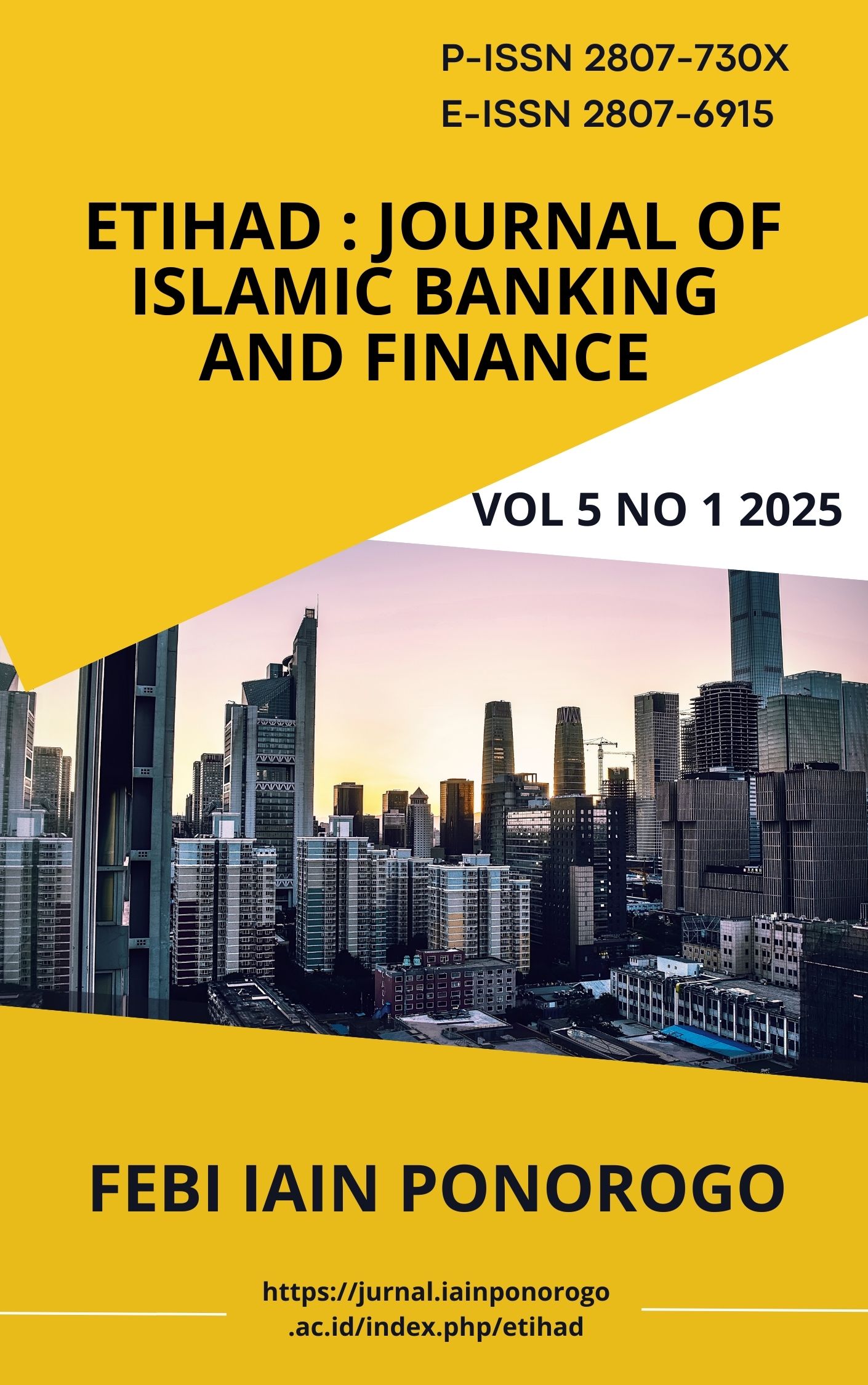Bridging Financial Knowledge and Investment Decisions: Evidence from Students of the Faculty of Islamic Economics and Business, IAIN Ponorogo
DOI:
https://doi.org/10.21154/etihad.v5i1.10532Keywords:
Financial knowledge; investment decision; capital marketAbstract
Introduction: Although awareness of financial literacy is increasing, participation in Indonesia’s capital market remains low, with only about 0.4% of the population actively investing. Therefore, this study aims to examine the factors influencing investment interest among students of the Faculty of Islamic Economics and Business (FEBI) at IAIN Ponorogo. Research Methods: A quantitative method was employed using questionnaires distributed to 212 fifth-semester students during the 2018/2019 academic year. Multiple linear regression was applied to examine the effects of investment knowledge and minimum investment policies on investment interest. Results: The findings reveal that investment knowledge has a positive and significant effect on students’ investment interest, while minimum investment policies show no significant effect. However, both variables jointly have a significant influence. Conclusion: The results highlight the need for capital market authorities and educational institutions to enhance financial literacy and encourage active student participation in investment activities.
References
Akhtar, F., & Das, N. (2019). Predictors of investment intention in Indian stock markets: Extending the theory of planned behaviour. International Journal of Bank Marketing, 37(1), 97–119. https://doi.org/10.1108/IJBM-08-2017-0167
Anan, M. W., & Devi, S. (2023). Pengaruh Modal Minimal, Tingkat Risiko, Return, Tingkat Pengetahuan Investasi, Lingkungan Sosial dan Fasilitas Online terhadap Minat Mahasiswa Berinvestasi di Pasar Modal. Jurnal Penelitian Dan Pengembangan Sains Dan Humaniora, 7(1), 48–60. https://doi.org/10.23887/jppsh.v7i1.49306
Ardiana, T. E., Sugianto, L. O., & Chamidah, S. (2020). The Influence of Minimum Investment Capital, Risk Perception of Students Investment in Indonesia Capital Market. International Journal of Economics, Business and Accounting Research (IJEBAR), 4(03). https://doi.org/10.29040/ijebar.v4i03.1248
Arpaci, I., Aslan, O., & Kevser, M. (2024). Evaluating short- and long-term investment strategies: Development and validation of the investment strategies scale (ISS). Financial Innovation, 10(1), 63. https://doi.org/10.1186/s40854-023-00573-4
Attrah, S. G. K. (2021). Multiple Linear Regression and It,s Statistical Indicators by Using Statistical Program Spss. International Journal of Humanities and Educational Research, 03(03), 119–133. https://doi.org/10.47832/2757-5403.3-3.12
Baskerville, R., & Dulipovici, A. (2006). The theoretical foundations of knowledge management. Knowledge Management Research & Practice, 4(2), 83–105. https://doi.org/10.1057/palgrave.kmrp.8500090
Daniel, K., Hirshleifer, D., & Teoh, S. H. (2002). Investor psychology in capital markets: Evidence and policy implications. Journal of Monetary Economics, 49(1), 139–209. https://doi.org/10.1016/S0304-3932(01)00091-5
Darmawan, A., Kurnia, K., & Rejeki, S. (2019). Pengetahuan Investasi, Motivasi Investasi, Literasi Keuangan Dan Lingkungan Keluarga Pengaruhnya Terhadap Minat Investasi Di Pasar Modal. Jurnal Ilmiah Akuntansi Dan Keuangan, 8(2), 44–56. https://doi.org/10.32639/jiak.v8i2.297
Faidah, F. (2019). Pengaruh Literasi Keuangan Dan Faktor Demografi Terhadap Minat Investasi Mahasiswa. JABE (Journal of Applied Business and Economic), 5(3), 251. https://doi.org/10.30998/jabe.v5i3.3484
Fitriani. (2021). Pengaruh Pengetahuan Investasi, Manfaat Investasi, Motivasi Investasi Dan Modal Minimal Investasi Terhadap Minat Investasi Di Pasar Modal (studi Pada Mahasiswa Fakultas Ekonomi Dan Bisnis Universitas Yapis Papua). Open Science Framework. https://doi.org/10.31219/osf.io/nje7g
Hasanudin, H. (2023a). Exploring the Interplay of Investment Knowledge, Motivation, Minimum Capital, and Risk Perception in Shaping Students’ Interest in Capital Markets. Jurnal Manajemen Dan Kewirausahaan, 11(2), 162–170. https://doi.org/10.26905/jmdk.v11i2.11073
Hasanudin, H. (2023b). Exploring the Interplay of Investment Knowledge, Motivation, Minimum Capital, and Risk Perception in Shaping Students’ Interest in Capital Markets. Jurnal Manajemen Dan Kewirausahaan, 11(2), 162–170. https://doi.org/10.26905/jmdk.v11i2.11073
Hassan Al‐Tamimi, H. A., & Anood Bin Kalli, A. (2009). Financial literacy and investment decisions of UAE investors. The Journal of Risk Finance, 10(5), 500–516. https://doi.org/10.1108/15265940911001402
Heckman, J. J. (2000). Policies to foster human capital. Research in Economics, 54(1), 3–56. https://doi.org/10.1006/reec.1999.0225
Hidayat-ur-Rehman, I. (2024). The role of financial literacy in enhancing firm’s sustainable performance through Fintech adoption: A moderated mediation analysis. International Journal of Innovation Science. https://doi.org/10.1108/IJIS-03-2024-0056
Kaharudin, E., & Vernando, A. N. (2020). Analisis Faktor-Faktor Yang Mempengaruhi Minat Berwirausaha (studi Kasus Mahasiswa Akademi Entrepreneurship Terang Bangsa Semarang). Integritas Jurnal Manajemen Profesional (IJMPRO), 1(2), 131–144. https://doi.org/10.35908/ijmpro.v1i2.20
Lu, Z., Li, H., & Wu, J. (2024). Exploring the impact of financial literacy on predicting credit default among farmers: An analysis using a hybrid machine learning model. Borsa Istanbul Review, 24(2), 352–362. https://doi.org/10.1016/j.bir.2024.01.006
Lucey, B. M., & Dowling, M. (2005). The Role of Feelings in Investor Decision-Making. Journal of Economic Surveys, 19(2), 211–237. https://doi.org/10.1111/j.0950-0804.2005.00245.x
Lusardi, A. (2019). Financial literacy and the need for financial education: Evidence and implications. Swiss Journal of Economics and Statistics, 155(1), 1. https://doi.org/10.1186/s41937-019-0027-5
Millett, C. M. (2020). Depicting the Ecosystems of Support and Financial Sustainability for Five College Promise Populations. ETS Research Report Series, 2020(1), 1–108. https://doi.org/10.1002/ets2.12299
Nadeak, T., Purnama, B. S., Sari, I. P., & Dariah, D. (2024). Pengaruh Pemahaman Investasi dan Modal Minimal terhadap minat Mahasiswa Berinvestasi di Pasar Modal (Studi Kasus pada mahasiswa Manajemen Keuangan 2019, Univerisitas Buana Perjuangan Karawang). Jurnal Akuntansi Dan Keuangan West Science, 3(01), 71–95. https://doi.org/10.58812/jakws.v3i01.867
Olssen *, M., & Peters, M. A. (2005). Neoliberalism, higher education and the knowledge economy: From the free market to knowledge capitalism. Journal of Education Policy, 20(3), 313–345. https://doi.org/10.1080/02680930500108718
Osborne, J. W., & Waters, E. (n.d.). Four assumptions of multiple regression that researchers should always test. https://doi.org/10.7275/R222-HV23
Rahmawati, Y., & Dwijayanto, A. (2021). The Effect of Moral Tax and Tax Compliance on Decision Making Through Gender Perspective: A Case Study of Religious Communities in Magetan District, East Java, Indonesia. Academic Journal of Interdisciplinary Studies, 10(6), 237. https://doi.org/10.36941/ajis-2021-0168
Regan, M. (2017). Capital Markets, Infrastructure Investment and Growth in the Asia Pacific Region. International Journal of Financial Studies, 5(1), 5. https://doi.org/10.3390/ijfs5010005
Reiter, L. (2015). Financial Literacy and the Academic Library: Exploring the Peer-to-Peer Approach. Journal of Business & Finance Librarianship, 20(1–2), 54–65. https://doi.org/10.1080/08963568.2015.977732
Remund, D. L. (2010). Financial Literacy Explicated: The Case for a Clearer Definition in an Increasingly Complex Economy. Journal of Consumer Affairs, 44(2), 276–295. https://doi.org/10.1111/j.1745-6606.2010.01169.x
Sari, V. M., Putri, N. K., Arofah, T., & Suparlinah, I. (2021). Pengaruh Motivasi Investasi, Pengetahuan Dasar Investasi, Modal Minimal, dan Kemajuan Teknologi terhadap Minat Investasi Mahasiswa. Jurnal Doktor Manajemen (JDM), 4(1), 88. https://doi.org/10.22441/jdm.v4i1.12117
Sharma, S., Charity, I., Robson, A., & Lillystone, S. (2018). How do students conceptualise a “real world” learning environment: An empirical study of a financial trading room? The International Journal of Management Education, 16(3), 541–557. https://doi.org/10.1016/j.ijme.2017.09.001
Sihombing, J. S., Purnawan, P. E., Sababalat, K. Z., & Tafonao, T. (2024). Analisis Faktor Faktor yang Mempengaruhi Minat Belajar Mahasiswa. Jurnal Ilmiah Multidisiplin, 1(2), 106–118. https://doi.org/10.62282/juilmu.v1i2.106-118
Soroko, A. (2021). The Politics of Teaching Financial Literacy Education: A Case Study of Critical High School Teachers’ Beliefs and Practices in Ontario and Québec. Université d’Ottawa / University of Ottawa. https://doi.org/10.20381/RUOR-26996
Van Rooij, M., Lusardi, A., & Alessie, R. (2011). Financial literacy and stock market participation. Journal of Financial Economics, 101(2), 449–472. https://doi.org/10.1016/j.jfineco.2011.03.006
Young, R. F. (2011). Planting the Living City: Best Practices in Planning Green Infrastructure—Results From Major U.S. Cities. Journal of the American Planning Association, 77(4), 368–381. https://doi.org/10.1080/01944363.2011.616996
Yusuf, M. (2019). Pengaruh Kemajuan Teknologi dan Pengetahuan terhadap Minat Generasi Milenial dalam Berinvestasi di Pasar Modal. Jurnal Dinamika Manajemen Dan Bisnis, 2(2), 86–94. https://doi.org/10.21009/JDMB.02.2.3
Downloads
Published
Issue
Section
License
Copyright (c) 2025 Yunaita Rahmawati, Raisha Salisa Ahmad

This work is licensed under a Creative Commons Attribution-NonCommercial 4.0 International License.
Etihad: Journal of Islamic Banking and Finance allow the author(s) to hold the copyright without restrictions and allow the author(s) to retain publishing rights without restrictions, also the owner of the commercial rights to the article is the author.







